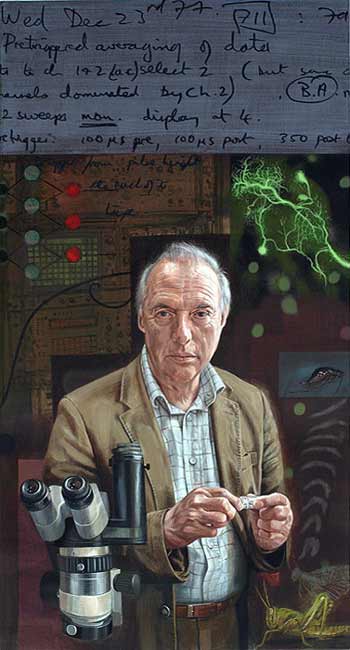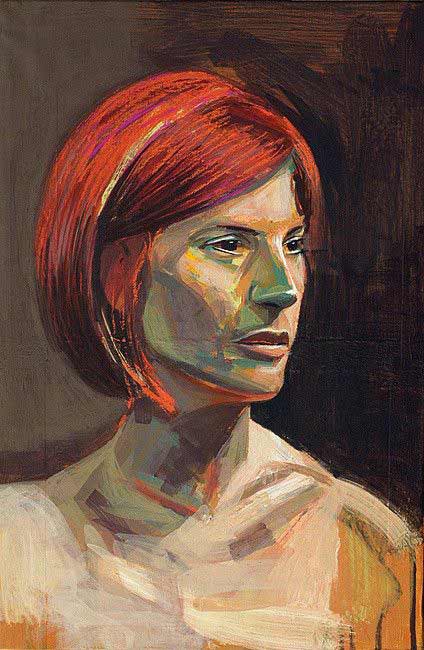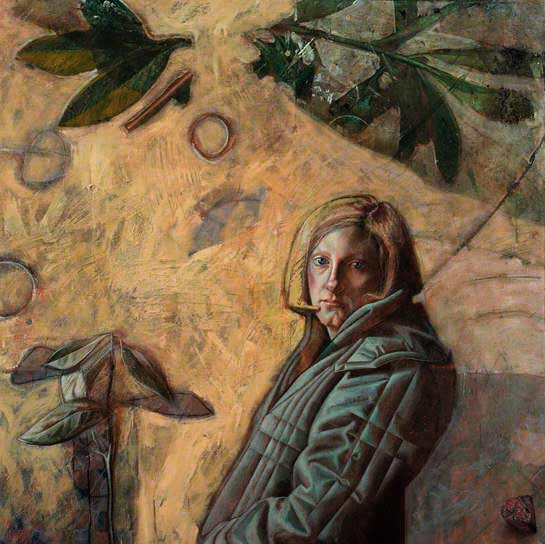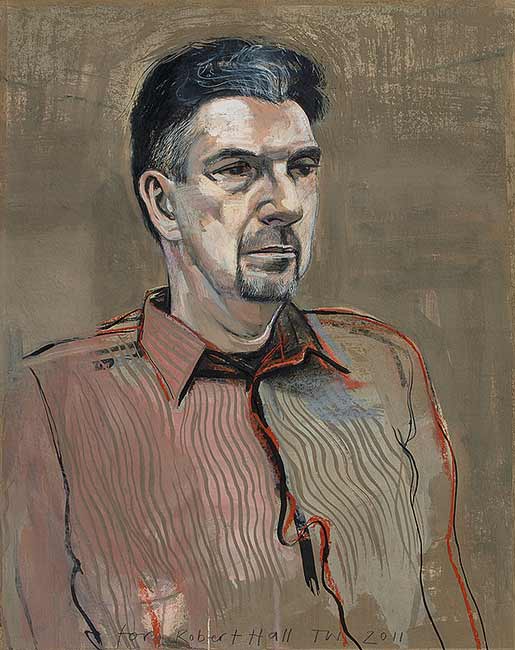Tom Wood, expressive drawings & portraits

Responsible for a broad body of work, both figurative and abstract Tom Wood uses every medium out there. With a sophisticated handling of materials he was producing similar effects to the layers and manipulation possible in Photoshop before it was even invented! “The digital manipulation of images only reinforced the notion that there were no boundaries and everything is worth trying.”
Exhibiting work worldwide since 1978 Tom’s most recently celebrated portraits are of Professor Lord Robert Winston and Alan Bennett, both commissioned by the National Portrait Gallery, London. Other notable commissions are his portraits for HRH Prince of Wales and Yale University.
Having painted portraits for over 40 years, he sits the model by a source of natural light but not too close otherwise the shadows are too harsh. Sadly due to time restrictions he has to resort to photographs as well. Tom initially strives to get a likeness then builds from there. Like Holbein, he uses symbolic references to evoke history and to suggest a narrative. “The symbols evolve over time as the meaning of the painting becomes clear, ultimately nearly all portraits whether consciously or unconsciously are about mortality. An interesting portrait should provoke curiosity about the sitter, so the viewer wants to know more, it shouldn’t be a settled argument.”

To get beyond the surface Tom tries not to think about fame or reputation instead focusing on his relationship with the sitter which usually evolves into one of mutual trust. “You have to care about them and they have to care about you and ultimately both of you must care about the painting, it’s a team effort.”

Confidently venturing into new combinations of materials such as; soft pastels on acrylics, Tom uses the medium appropriate to a certain idea and ensures quality is always maintained. Enjoying painting at extreme scales of big and small he finds they each bring their own particular problems and rewards. “There is something invigorating and exciting about starting a large painting. You have to straighten your back, stiffen your sinews, take deep breaths and really go for it, optimism and energy is essential. Timid half measures just won’t do. Everything is scaled up, so big brushes and rollers, big quantities of paint and a big studio, is required. To hold even the heaviest and largest of works, Tom has his own custom made peg board easel. With the pegs being six inch nails it is simple yet highly effective and can be leaned up against any wall. On occasions he likes the crudity and simplicity of using an old fashioned overhead projector. “I don’t rely on it but realise its potential is enormous.”

Sennelier Etude oil paints are favoured for their fluidity and their reasonable price, which is an important factor when needed in large quantities. A mixture of linseed oil and white spirit is used to dilute the oils when necessary. Painting with maximum freedom he avoids rules and too much pre-consideration. “I was taught colour theory, so I have it there in the back of my mind as a tool, like perspective but I never set out to use it consciously. Painting is a voyage of discovery hovering between success and failure; forgotten things get remembered and new things are discovered. I paint to understand not to illustrate.”
Being a tonal painter Tom does not have a constant palette of colours. “I mix up small bowls of oil paint that I can use with big wide brushes so the colours rarely stay pure.” He opts for Spectrum Wax lightly diluted with white spirit and linseed oil as a thick transparent glazing medium to retain flexibility. “If the works are going to be glazed, I don’t varnish. I like a raw, authentic surface that doesn’t hide its making.” On occasions where some of the darker colours have sunk he finishes by spraying with Windsor and Newton Satin Varnish.
Tom has hundreds of brushes. “Since my time in Hong Kong I’ve discovered how lovely Chinese brushes are when using fluid oil paint. A cheap brush can be made useful by judicious trimming; nearly all my brushes have been modified in some form or other. I particularly like long bristled brushes, soft or hard, as they can be flexible and very expressive. I also use palette knives and scrapers and unexpected techniques like using carpet underlay, to print on textures, pipettes and modified rollers.”

Tom has witnessed how artists develop creatively and gain confidence by having Photoshop skills. Previously he led workshops with teachers demonstrating methods by which traditional techniques could be melded with computer skills to create new and interesting artwork.

Tom still uses the computer a lot but he finds drawing is the cornerstone of making art. “It helps to develop motor skills, trains your eye and gives the opportunity to experiment and develop ideas as well as grow in confidence.” Tom draws from a model once or twice a week, occasionally studying one pose over a two day session, which he enjoys enormously and from which he has learned a tremendous amount. He runs classes, including making your own pastels, and life drawing sessions in partnership with fellow artist, Tony Noble.
Tom Woods
Excerpted from The Artist magazine May 2016 by Caroline Saunders.
May 7, 2016
